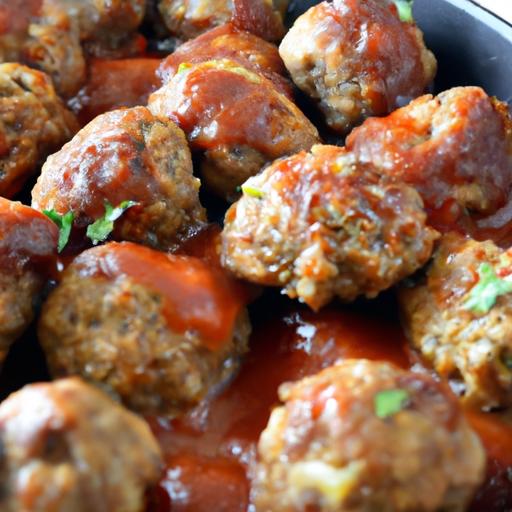There’s a certain alchemy to the perfect meatball – that ideal harmony of juicy tenderness, tantalizing aroma, and mouthwatering flavor that transforms a humble mixture of ground meat, herbs, and spices into pure culinary magic. But beneath this seemingly simple delight lies a fascinating science, where chemistry and technique dance together to create texture, moisture, and taste that captivate our senses. In this article, we’ll unravel the secrets behind the perfectly baked meatball, exploring the precise processes that turn ordinary ingredients into golden-brown spheres of savory perfection. Prepare to discover the delicious intersection of food science and kitchen artistry that makes every bite a masterpiece.
The Science Behind the Perfectly Baked Meatball Magic is a fascinating journey into how precise ingredient choices, thoughtful temperature control, and skillful blending come together to create irresistibly juicy, flavorful meatballs. This culinary adventure is inspired by timeless homecooked traditions, adapted with scientific insight to ensure every bite delivers that comforting blend of softness and snap that defines a premium meatball.
Prep and Cook Time
- Preparation: 20 minutes
- Baking: 25 minutes
- Total Time: 45 minutes
Yield
Yields approximately 24 meatballs (serves 6-8)
Difficulty Level
Medium – Perfect for cooks ready to step up their meatball game with science-backed confidence
Ingredients
- 1 lb ground beef (80% lean for optimal fat content)
- 0.5 lb ground pork (for flavor and juiciness)
- 1/2 cup fresh breadcrumbs (preferably from day-old rustic bread)
- 1/3 cup whole milk (to hydrate breadcrumbs and keep texture soft)
- 1 large egg, lightly beaten (binding and moisture)
- 1/4 cup grated Parmigiano-Reggiano (adds umami depth)
- 2 cloves garlic, finely minced
- 2 tbsp finely chopped fresh parsley
- 1 tsp kosher salt
- 1/2 tsp freshly cracked black pepper
- 1/2 tsp smoked paprika (optional, for subtle sweet heat)
- Olive oil for drizzling
Instructions
- Hydrate the breadcrumbs: Combine the fresh breadcrumbs and whole milk in a small bowl. Allow to sit about 5 minutes until the breadcrumbs absorb the milk and form a soft paste. This step ensures juiciness by retaining moisture in the meatballs.
- Prepare the meat blend: In a large bowl, gently combine the ground beef and ground pork without overworking the meat to preserve tenderness.
- Mix binding agents: Add the hydrated breadcrumbs, beaten egg, grated Parmigiano-Reggiano, minced garlic, parsley, salt, black pepper, and smoked paprika to the meat blend.
- Combine carefully: Using your hands or a wooden spoon, mix ingredients just until evenly incorporated. Overmixing activates excessive protein development, leading to denser meatballs.
- Form meatballs: Shape the mixture into uniform 1.5-inch spheres. Uniform size ensures even cooking and a professional presentation.
- Preheat the oven: Set your oven to 400°F (200°C). Using high heat will produce evenly cooked meatballs with a golden crust and tender interior.
- Bake the meatballs: Lightly drizzle olive oil on a parchment-lined baking sheet and arrange meatballs spaced apart. Bake for 20-25 minutes, or until an internal temperature of 160°F (71°C) is reached-use a meat thermometer for precision.
- Rest before serving: Remove from oven and let the meatballs rest 5 minutes-this allows juices to redistribute for maximized moistness.
Tips for Success
- Choose your meat wisely: The ideal ratio around 80:20 for beef and a fattier cut of pork provides a perfect fat balance for flavor and texture.
- Use fresh breadcrumbs: Day-old rustic bread blitzed lightly in a food processor works best. Avoid dry crumbs to prevent dryness.
- Bind gently: Avoid heavy mixing as it tightens gluten and toughens your meatballs.
- Monitor internal temperature: Using a reliable meat thermometer guarantees perfect doneness without overcooking.
- Make ahead: Form meatballs and freeze on a baking tray, then transfer to a bag for up to 3 months. Bake directly from frozen, adding 5-7 minutes to baking time.
Serving Suggestions
Serve hot meatballs atop a bed of al dente spaghetti, drizzled with robust marinara and topped with fresh basil leaves and a dusting of grated Parmesan. Alternatively, plate with creamy polenta or nestled in crisp toasted buns for hearty meatball sliders. Garnish with chopped parsley and a fiery chili oil drizzle for elevated visual appeal and flavor impact.
| Nutrient | Per Serving (3 meatballs) |
|---|---|
| Calories | 320 kcal |
| Protein | 22 g |
| Carbohydrates | 7 g |
| Fat | 22 g |
Explore more about meat blends and textures to deepen your expertise. For further scientific insights into meat cooking temperatures, consult the USDA Food Safety and Inspection Service.

Q&A
Q&A: The Science Behind the Perfectly Baked Meatball Magic
Q1: What makes a meatball “perfectly baked” rather than just cooked?
A1: It’s all about balance-moisture, texture, and flavor. Perfectly baked meatballs achieve a tender interior without drying out, paired with a slightly crisp, caramelized crust on the outside. The magic lies in how heat transforms proteins and fats, sealing in juices while creating that irresistible golden finish.
Q2: How does baking compare to frying when cooking meatballs?
A2: Frying delivers a quick, intense heat that crisps the exterior swiftly but can risk uneven cooking inside. Baking uses consistent, gentle heat that cooks meatballs evenly throughout, allowing fat to render slowly and flavors to meld harmoniously. Plus, baking is hands-off and less messy-kitchen science meets convenience!
Q3: Why is the temperature and baking time so crucial?
A3: Temperature controls the delicate dance of protein coagulation and fat rendering. Too high, and the outside burns before the middle cooks; too low, and you risk a pale, dry meatball. Typically, baking at around 375°F (190°C) strikes the perfect balance, usually between 20 to 25 minutes, depending on size.
Q4: Does the meat mixture composition affect baking results?
A4: Absolutely! The ratio of lean to fatty meat influences juiciness and texture. Adding breadcrumbs soaked in milk or eggs acts like a moisture sponge and binder, stabilizing the meat matrix and preventing crumbly results. Herbs, cheese, or finely chopped veggies contribute to flavor and moisture dynamics too.
Q5: How does the Maillard reaction enhance meatball taste in baking?
A5: The Maillard reaction is culinary chemistry at its finest-it’s the browning process that creates complex, savory notes and irresistible aromas. Baking triggers this reaction on the surface, where amino acids and sugars mingle under heat, giving baked meatballs their signature depth and allure.
Q6: Can baking meatballs be considered a healthier option?
A6: Yes! Baking requires little to no added oil, meaning less fat compared to pan-frying. Excess fat drips away in the oven, resulting in leaner meatballs. It’s a win-win: delicious, juicy bites with a mindful nutrition profile.
Q7: What kitchen tips help ensure baking success for meatballs?
A7: Use a light oil coating or parchment paper to prevent sticking without overloading fat. Space meatballs evenly on the pan for optimal air and heat circulation. Rotate the baking tray halfway through to promote even browning, and resist the urge to over-handle the mixture, which can toughen the texture.
Q8: What’s the final secret to “meatball magic” in baking?
A8: Patience and respect for the science. Trust the process of heat, time, and ingredient alchemy. When you combine quality ingredients, the right ratios, and thoughtful baking technique, the oven works its magic-delivering meatballs that are juicy, flavorful, and perfectly baked every time.
Final Thoughts
As the aroma of a perfectly baked meatball fills the kitchen, we realize that this humble yet magical morsel is much more than just a comfort food. It’s a symphony of science and art, where chemistry unlocks flavor and texture, and temperature mastery ensures every bite is juicy and tender. Understanding the science behind this culinary classic elevates the meatball from a simple dish to a delicious experiment in perfection. So next time you savor that golden, flavorful orb, remember – it’s not just cooking, it’s edible science at its finest.


